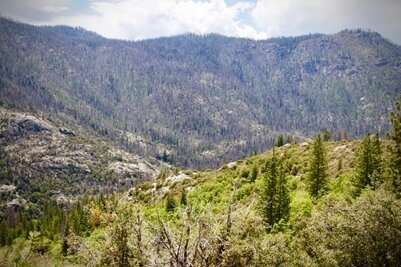After a natural mixed-severity forest fire in the Sierra Nevada, California, there remains a variety of effects on vegetation, including large high-severity burn patches where most or all the trees are killed. New research found the size of these high-severity burn patches is not increasing. Credit: D. DellaSala
A peer-reviewed study by leading experts of forest and fire ecology recently published in the science journal Diversity disputes the widely held belief that "megafires" in U.S national forests are increasing, preventing forests from re-growing, and that logging is necessary to prevent these wildfires. While many policy and management decisions in U.S. national forests are based on these assumptions, the new research shows that large patches of trees killed by wildfires—known as high-severity burn patches—have not been increasing. These findings confirmed that taxpayer-funded logging projects on public lands are not only unnecessary, they are counter-productive, as related research found that such logging often increases fire severity and slows natural regrowth.
In their megafire trend study, researchers analyzed datasets collected on large (over 1,000 acres) high-severity burn patches across 11 western dry pine and mixed-conifer forests over three decades. They found no significant trend in the size of large high-severity burn patches between 1984 and 2015, disputing the prevailing belief that increasing megafires are setting back post-fire forest regeneration. "This is the most extensive study ever conducted on the high-severity fire component of large fires, and our results demonstrate that there is no need for massive forest thinning and salvage logging before or after a forest fire," says Dr. Dominick A. DellaSala, lead author of the study and Chief Scientist at the Geos Institute. "The perceived megafire problem is being overblown. After a fire, conditions are ideal for forest re-establishment, even in the interior of the largest severely burned patches. We found conditions for forest growth in interior patches were possible over 1000 feet from the nearest low/moderately burned patch where seed sources are most likely."
DellaSala and co-author Dr. Chad Hanson of the John Muir Project used computer mapping databases to investigate vegetation and fire severity trends in large, severely burned forest patches, out of which grow "complex early seral forests" or "snag forest habitats"—unique and ecologically rich areas that are comparable to old forests in terms of native biodiversity and wildlife abundance. They analyzed these patches in four equal time periods from 1984 to 2015 using U.S. Geological Survey fire severity datasets. They found an increase in large burn patches only during the 1980s and early 1990s, followed by a flat pattern to the present day.
"We will use these findings to counter ill-conceived post-fire logging projects on the Stanislaus National Forest in the Sierra Nevada," says Dr. Hanson. "The U.S. Forest Service, assisted by The Nature Conservancy and Sierra Nevada Conservancy, is proposing to clearcut several thousand acres of prime snag forest habitat based on their false assumption that the forest cannot rejuvenate on its own and is better off being converted to wood chips for biomass energy production, which worsens the climate crisis."
The study concludes that over the past three decades, the interval between large, high-severity burn patches at the landscape scale averaged 12 centuries to over 4,000 years, allowing more than ample time for forests to regenerate and develop into old-growth areas. Evidence was found in historical records of even larger high-severity burn patches, countering claims that contemporary high-severity burn patches are unprecedented and forests cannot recover on their own.
"This paper is critical to wildlife conservation in fire-dependent forests, as it dispels notions that large, high-severity fires are unnatural and catastrophic," says Monica Bond, a fire ecology researcher with the Wild Nature Institute, who was not involved in the study. "An entire community of native wildlife and plants depends on these large burns, I have documented spotted owls, songbirds, and woodpeckers using these large high-severity burn patches for both foraging and nesting."
More information: Dominick A. DellaSala et al. Are Wildland Fires Increasing Large Patches of Complex Early Seral Forest Habitat?, Diversity (2019). DOI: 10.3390/d11090157
Provided by Wild Nature Institute
























